Essential Guide to Bathing Large Parrots for Health
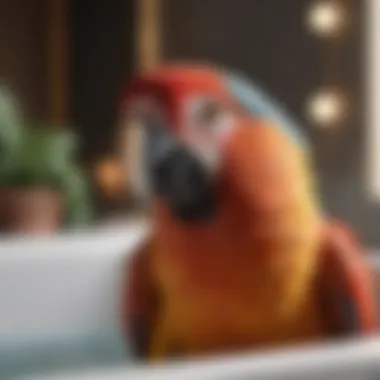
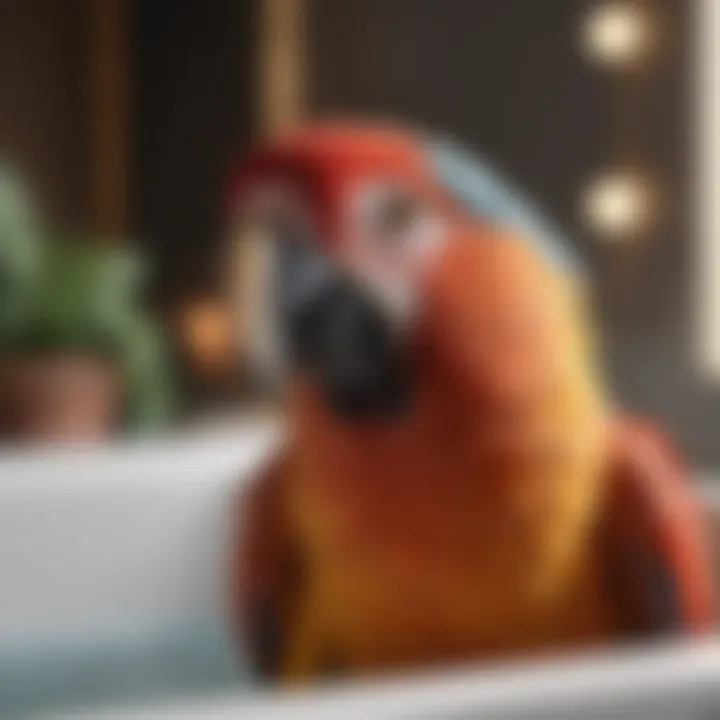
Intro
Bathing is a crucial part of caring for large parrots. It involves not just providing water, but creating an environment that promotes hygiene and natural behaviors. Large parrots, such as macaws and African greys, thrive when their bathing needs are met. Owners often seek guidance on when and how to offer a bath that is not just effective, but enjoyable for their pets.
Different large parrot species have distinct preferences for bathing. Some may prefer a mist from a spray bottle, while others might enjoy a deep bowl to splash around in. Understanding these preferences will lead to better bathing experiences. This guide will highlight the key aspects of bathing your large parrot, including types of baths, frequency, and how this activity contributes to their health.
Care Tips
Daily Care Routines
Regular care for large parrots must include bathing. Scheduled routine is best. You might consider bathing your parrot every few days, or even daily, depending on your bird's likes. Familiarizing your parrot with the bathing routine creates a sense of comfort.
Cage Setup and Maintenance
The setup of your cage plays a significant role in your parrot's bathing preference. Accessories like shallow water bowls or compact shower areas can be added. Furthermore, it is important to keep bathing spaces clean. This means promptly replacing soiled water and ensuring there is no dirtspots too close to the areas used for perching or feeding.
Hygiene and Cleaning Practices
It is vital to maintain cleanliness for both health and comfort. Bath items should be rinsed daily. This prevents bacteria growth that could be harmful to your pet. Use natural cleaning solutions to deodorize and sanitize. Avoid using harsh chemicals, as their fumes can negatively affect your bird.
Seasonal Care Adjustments
During warmer months, birds often enjoy bathing outdoors. Ensure these sessions are supervised for safety. In colder months, provide warm-water baths or use training to assist your parrot in relying on misting with a spray bottle. Just be mindful of drafts or chilliness indoor.
Understanding the Importance of Bathing Large Parrots
Bathing is not just a luxury for large parrots; it is an integral aspect of their overall care. Understanding why proper bathing is significant can help bird owners enhance the health and well-being of their feathered companions. Keeping large parrots clean is essential for maintaining their hygiene, preventing various illnesses, and ensuring healthy feather growth. In this section, we will explore two key aspects of the importance of bathing: hygiene and general health, as well as the behavioral benefits associated with regular baths.
Basic Hygiene and Health
Bathing serves as a fundamental practice in ensuring good hygiene for large parrots. Birds naturally engage in bathing behaviors in the wild, where they use various methods to clean their feathers and remove dust, debris, and parasites. Domestic settings often disconnect birds from such natural habits, which is why it becomes essential for owners to mimic these behaviors.
Hygiene promotes better skin condition, avoiding issues like excess oil buildup that could otherwise lead to unwanted infections or degraded feather quality. Furthermore, as larger birds may be prone to specific health conditions that affect their skin or feathers, providing frequent bathing opportunities can preemptively tackle multiple concerns.
Skip baths at your peril, it might not just lead to a smelly pet, but it can also jeopardize the overall health. Consider regular bathing to be part of the essential care routine for your large parrot, helping reduce the vet visits and keep conditions like dermatitis and feather plucking at bay.
Behavioral Benefits
The gentle act of bathing can do wonders for a bird's mental well-being as well. Many large parrots experience stress due to confined living space or emotional unmanagement. Bathing not only encourages instinctual behavior but also alleviates anxiety. Engaging them in this practice can relieve frustrations built from boredom caused by a monotonous environment.
Moreover, the sensation of water and engaging in the bathing ritual can promote excitement and encourage interactive, playful behavior. As unpredictable as birds can be, incorporating regular bath times can improve the bond between the bird and its owner as they witness their parrot's joyful reactions to the water. Setting aside a specific time for bathing might become not just beneficial in hygiene but also therapeutic, paving the way for more lively and durable companionship.
By nurturing not just the hygiene but the playfulness of your large parrot, you significantly contribute to its happiness, enhancing every moment shared together.
Types of Baths Suitable for Large Parrots
Bathing is a necessary part of a large parrot's care routine. The type of bath you choose impacts your bird's grooming and overall health. Each option has unique advantages. Understanding these can optimize the bath experience. Several factors that influence bath choice include the bird's personality and environment.
Shallow Water Baths
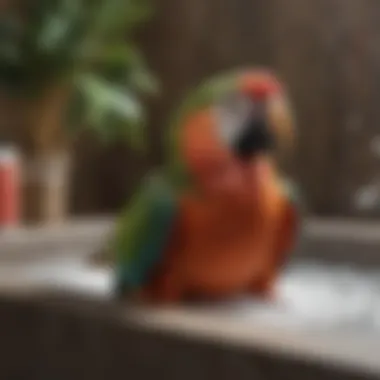
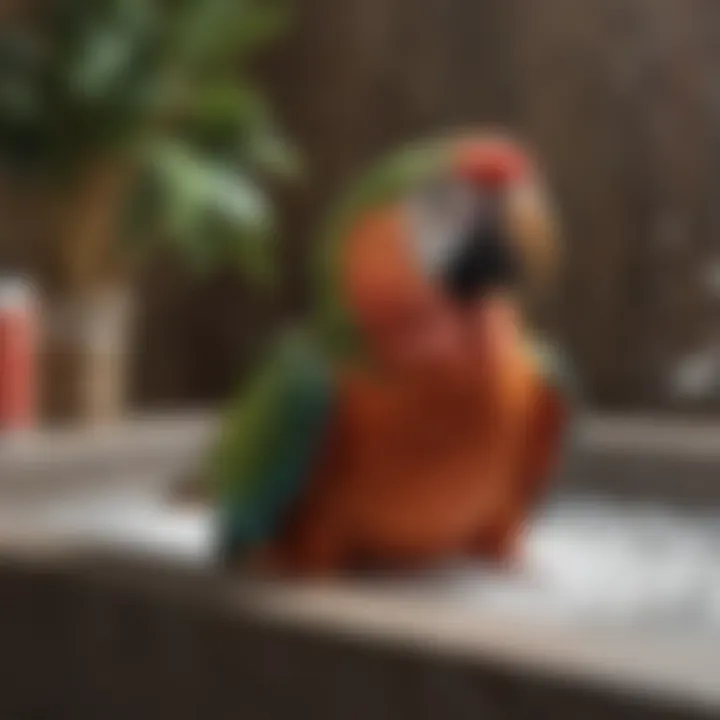
Shallow water baths are a common method for bathing large parrots. This type of bath typically includes a small, shallow container of water. The water should allow the parrot to sit comfortably while being able to splutter and splash around.
The benefits of shallow water baths are considerable. They are easy to set up. You can use common household items like large bowls or basins. In addition to hygiene, these baths can also stimulate your parrot's natural instinct to splash in water. However, monitor the water temperature and depth. This helps ensure your bird will feel secure and safe.
Misting and Spraying
Misting and spraying is another effective method. Using a spray bottle filled with fresh, lukewarm water can create a refreshing experience for your parrot. The gentle droplets fall lightly on the feathers. This replicates rainfall. This method is generally Low-stress for the bird and allows for targeted soaking of areas that need it most.
When should you mist? Aim for days when the air is dry or during a bathing cycle. Too frequent misting can stress the parrot. Just enough moisture encourages healthy feather conditions but does not soak the bird excessively.
Shower Baths
Shower baths are a popular way to bathe large parrots. This involves taking your bird into the shower along with you. Many parrots find this collision of human-bird environment bonding beneficial. Knows some birds love water. You can let your parrot stand on a secure surface while gently misting them from above.
Though it can really be fun, watch the water pressure. It should not overwhelm your pet. Ensure the water is at a comfortable level. Consider your bird's reactions; some may take time to enjoy this activity.
Bathing Pool Setup
Bathing pools are ideal for larger species of parrots. To set up a bathing area, you will need a safe and functional space. Selecting a corner of your bathroom or backyard is wise. Ensure the area has easy access to hose water. Fill a small kiddie pool or basin with enough water for your parrot to splash.
There are few things to think about:
- Drainage: ensure your bird can exit easily.
- Space: the location must be quiet and comfortable.
- Supervision: Always supervise your parrot during bath time.
Pools provide a thorough bath experience. Frequent soaking can facilitate feather maintenance and promote a healthy plumage. Incorporate bath time remotely within a daily routine.
Ensuring quality and enjoyable bathing experiences is critical for a large parrot's well-being.
Choosing the right bath method creates opportunities to bond. Take the time to learn your parrot's preferences. Monitoring how they react to various methods is crucial for adjusting your approach. Each bath type contributes positively to their feeding and nurturing roles.
Frequency of Baths for Large Parrots
Understanding the frequency of baths is crucial for maintaining the well-being of large parrots. Regular bathing plays an important role in their hygiene, health, and overall behavior. Finding the right balance is necessary to cater to their individual needs without overwhelming them.
Seasonal Considerations
The frequency of giving baths to large parrots can depend greatly on seasonal changes. For example, during the warmer months, parrots tend to engage in more active bathing behaviors. They may take more frequent baths, as the heat can lead to increased perspiration and higher skin and feather care needs. As water becomes a pleasant reprieve from the heat, many parrots will naturally seek out more opportunities for bathing. Conversely, during colder months, the need for baths may decrease significantly. Incorrect bathing frequency during this period could result in birds struggling to maintain body heat, issues related to feather conditions, or even respiratory infections from damp surroundings.
Consideration Factors:
- Humidity levels: High humidity might increase bathing behavior.
- Temperature: Warm weather may encourage more baths, while cooler climates often reduce it.
- Indoor heating: If keeping birds in heated environments, assess if that's leading to dryness that could require more moisture through bathing.
It is essential for parrot owners to study their birds' behavior during these variations in climate and adjust bath frequencies accordingly.
Signs Your Parrot Needs a Bath
Recognizing when a large parrot needs a bath is vital for ensuring its comfort and health. There are clear indicators to observe. A feeling of dullness in feathers is one sign they may need bathing. When feathers appear oilier or worse for wear, most flocks may instinctively start preening furiously. Other signs may include flairing of feathers or seeking solace around the safety of water. Make a note of ingredients in their diet that might contribute to a dull down or skin irritations.
Regular observation is key: An always clean-looking parrot may quantifiably require baths watch on their overall health activities.
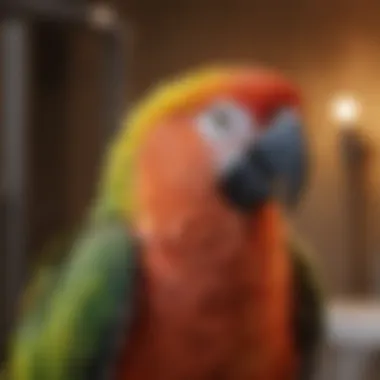
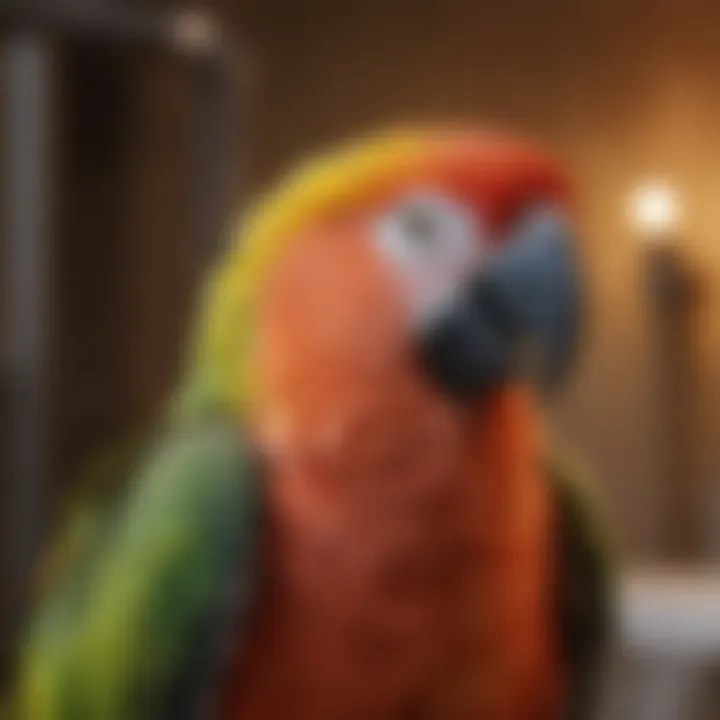
Below are common signs to know:
- Dirty feathers: If feathers seem matted or dirty, that's a sign a bath is in order.
- Excessive preening: Noticeable fussing over appearance might indicate discomfort in their external layers.
- Boredom or restlessness: Seeking a difference in activity can trigger a bath necessity.
- Skin irritation: For parrots that shows signs of flaking or dry patches, a bath’s moisture may alleviate discomfort.
- Behavioral Changes: If your parrot shows unusual behavior or seems unhappy, it may signal a need for a bath to enhance comfort.
By remaining attentive to these cues, parrot guardians can ensure their pets enjoy a proper bathing routine that combines frshness with stimulation. Regular adjustments bringing knowledge onclimate trends provide harmony with their feathered state.
Preparing for Bath Time
Preparing for bath time is a crucial element in ensuring a positive experience for large parrots. This stage involves creating an environment that promotes comfort, reducing stress, and making birds more receptive to bathing. Particularly for larger species, which might show apprehension towards water initially, a well-thought-out preparation sets the groundwork for a relaxed and effective bathing session.
Creating a Comfortable Environment
Creating a comfortable environment plays a significant role in avian bathing practices. Many parrots exhibit anxiety toward water due to past experiences or just their natural tendencies. To counteract this, take time to familiarize your parrot with the bathing setup beforehand. Make your bathing area quiet and soothing.
Consider using familiar perches or toys nearby to create a sense of normalcy. However, these satisfy instinctual behaviors by not overdoing distractions either. In this context, assess the location; ensure good visibility of surroundings, and a temperature that is not too cold or too warm.
Furthermore, the type of water matters. Fresh, clean water encourages a parrot to feel secure during bathing. Testing their interest in a shallow pan of water or a few drops during misting can build confidence. Parrots are creatures of habit and can learn to associate bath time with comfort if the environment is appropriate.
Safety Precautions
While a bath provides essential hygiene, participant safety should never be overlooked. Ensuring a safe bathing environment safeguards the wellbeing of your bird. The first important aspect is to monitor the water temperature, ensuring it is lukewarm. Extreme water induces stress, which defeats the purposes of bathing.
Next, directly supervise your parrot during bath time. Overly ambitious flying or maneuvering after bath time can lead to unwanted accidents, especially in shiny, wet conditions. It is also** important to remove hazardous items, either movable items or delicate decor, that could create risk of falls or injuries. Each bath must align with both comfort and security.
Lastly, ensure the area has no draughts. Sudden temperature changes during or after a bath may cause discomfort and stress for your bird. By following the precautions noted, an effective bath routine can genuinely benefit the emotional well-being of your large parrot.
Bathing Methods for Large Parrots
Bathing plays a crucial role in the overall health and well-being of large parrots. Understanding the different bathing methods can guide parrot owners in creating an enriching experience for their birds. Each parrot has unique preferences, so being observant and adaptable is essential. The following methods will explore direct bathing techniques and ways to encourage natural bathing behavior, helping parrots maintain cleanliness and comfort.
Direct Bathing Techniques
Direct bathing involves actively getting the parrot into the water. This hands-on approach can effectively ensure that the bird gets thoroughly cleaned. Owners must be gentle while maintaining a calm atmosphere. Here are a few effective techniques:
- Shallow Water Trays: A shallow tray adds an easy and accessible area for your parrot to splash around. Make sure the water level does not exceed the bird’s chest height.
- Portable Mist Sprayers: These handheld sprayers can mist the parrot gently. This method simulates rain, which many large parrots enjoy.
- Direct Shower Method: Some parrots enjoy showering under a lukewarm spray of water. It is advisable to use a detachable shower head and control the water pressure carefully.
Ensure the water temperature is comfortable for your parrot. Observing body language, such as flapping and vocal reactions, helps determine if your parrot enjoys the bathing approach. If they seem distressed, cease the activity and try again another time.
Encouraging Natural Bathing Behavior
Encouraging natural bathing behavior is equally vital as giving direct baths. Large parrots in the wild partake in water activities regularly. Mimicking this can foster well-being at home. Some strategies include:
- Setting Up Bird Baths: Installing a birdbath within their reach can invite everything from splashes to playful dips. Use water that is clean and kept at comfortable temperatures.
- Sunbathing Opportunities: Allowing your parrot moments of sun exposure not only elevates mood but also provides warmth, attracting pelts of humidity—all great enhancers for natural bathing.
- Providing Variety: Experiment with different settings or personnel during bath time. The avian environment can be stimulating. Rotate tray setups and placements until you find what resonates.
Encouraging natural behaviors builds a trust bond. Birds appreciate choice; therefore, offering several options maximizes their comfort during bath time.
Understanding both direct and natural bathing methods creates a wholesome bathing experience, impacting your parrot’s mental as well as physical health.
Utilizing a mixture of these bathing methods caters to various parrot personalities. Observing behaviors can only aid owners to provide a safe and amenable setup. Through careful attention, owners will set the stage for hygienic and enjoyable bathing experiences for their beloved parrots.

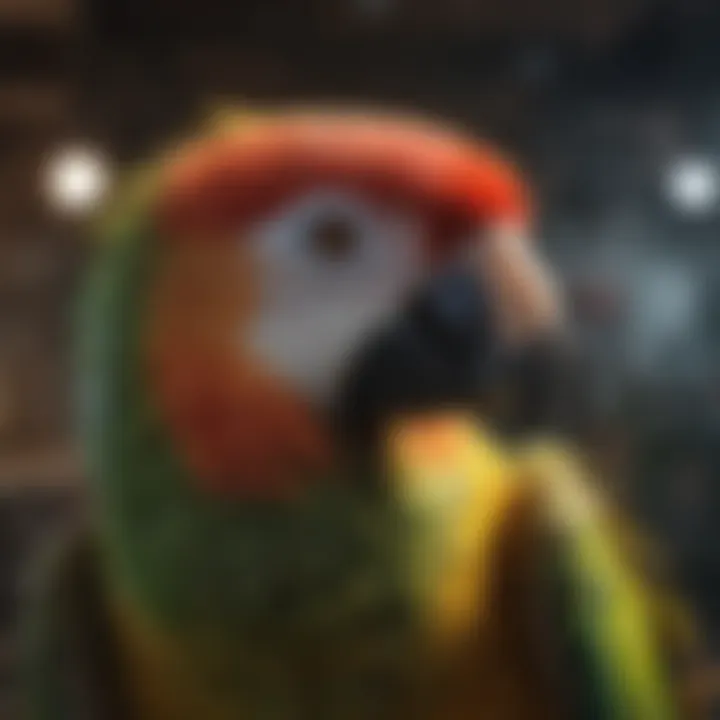
Post-Bath Care
Post-bath care is crucial for maintaining the health and well-being of large parrots. After a bath, parrots face the challenge of drying off, which is essential to avoid getting cold or stressed. Providing the right post-bath care can ensure your bird maintains optimal hygiene and comfort. Addressing drying techniques and health monitoring directly after bathing promots longer-term well-being.
Drying Techniques
Proper drying is necessary to keep a parrot healthy post-bath. Here are some techniques to consider:
- Air Drying: Most parrots can dry naturally without intervention. Placing them in a warm, draft-free environment will help.
- Towel Drying: Gently using a clean, soft towel to absorb excess water is sometimes needed. Make sure you are slow and calm to avoid stressing your pet.
- Heat Sources: An animal room heater can assist in effective drying, provided it is at a safe distance.
Tips for Effective Drying
- Ensure the environment is quiet to avoid stress.
- Keep temperature moderate to prevent overheating.
- Watch your bird's behavior closely. If it shows signs of discomfort, reduce heat or adjust your technique.
Monitoring Health After Bathing
Once the bathing ritual is over, it is important to check your parrot. Monitoring its health will help you catch potential issues early. Here are some key aspects to observe:
- Behavior: Look for signs of stress or lethargy after the bath. If something seems off, it may warrant further attention.
- Fur Condition: Drying habits and skin appearance talking great emphasis on the overall health. Check for dry patches or irritation that could arise.
- Input and Output: Observe feeding and drinking habits post-bath. Changes in appetite and water intake could signal health issues.
It is wise to remain them playful during the post-bath phase. Engage them with familiar toys to lighten their mood.
In summary, careful post-bath care plays a vital role in keeping large parrots healthy. Implementing effective drying techniques and closely monitoring your bird's condition can promote longevity and better overall health.
Common Issues and Solutions
Addressing common challenges in the bathing routines of large parrots is vital for both their health and the bond they share with their owners. Understanding these issues is not merely about correcting a problem, but it also helps in fostering a more enjoyable and stress-free experience for both the parrot and the caregiver. Confronting problems directly and developing strategies to overcome them plays a significant role in ensuring proper hygiene and emotional well-being for large parrots.
Aversion to Water
Water aversion is a frequently reported issue among large parrots. Some birds display signs of reluctance or outright refusal to engage with water, which not only complicates bathing routines but also poses health risks resulting from inadequate cleanliness. There are multiple reasons that can lead to such reluctance, including a particularly harsh experience at a young age or simply a lack of familiarity with the bathing process.
A solution to this concern involves gradual and patient exposure. Begin by introducing water in a non-threatening way, such as using a spray bottle set to fine mist, or providing shallow water baths that do not overwhelm the parrot. The goal is to associate the experience of water with comfort and pleasure. To facilitate this, incorporate gentle positive reinforcement by offering treats or praise when the bird shows interest or interacts positively with water. Using natural behaviors, such as misting when the bird is already active and cheerful can also help change its perception of bath time.
Skin Irritations
Skin irritations can occur after frequent bathing, leading to discomfort for your parrot. Such reactions may stem from exposure to chlorine, soaps, or irregular temperature of water. Ensuring that the bathing water is free from irritants transitions skin care into a priority.
Once skin irritation surfaces, assess your parrot's environment and grooming regimen. For one, evaluate past products used during bathing; ideally, one should opt for hypoallergenic products specifically made for birds. Additionally, utilize warm water that's at an appropriate temperature, considering arid house conditions during winter months. Importantly, ensure that your parrot is fully dried and is not left with any damp feathers that can lead to further issues such as fungal infections.
An ongoing vigilance towards the products you use, together with close observation for signs of skin conditions can safeguard your parrot's long-term well-being.
To summarize, actively engaging with your parrot during the bathing process can help mitigate aversion, while careful selection and preparation can prevent skin irritations. Taking the time to understand common bath-related issues lays a strong foundation towards a happy bathing experience for your large parrot.
Ending
Regular bathing for large parrots is a critical aspect of their overall care and well-being. This article has detailed various components, ranging from understanding the importance of bathing to identifying suitable methods and potential solutions to common issues. Each element plays a role in ensuring that our feathered companions remain healthy, both physically and behaviorally.
Summarizing the Benefits of Regular Bathing
Bathing serves multiple functions that significantly contribute to the health of large parrots. Firstly, it promotes basic hygiene, helping to remove dirt, feathers, and debris that can accumulate on their feathers or skin. Proper feather care not only keeps your parrot looking pristine but also supports their ability to regulate body temperature effectively. This aspect is especially important during varying seasons when temperatures fluctuate.
Behaviorally, regular bathing can enrich the lives of large parrots. Parrots often enjoy water and use bathing as an opportunity to engage in natural, instinctive behaviors. By providing them with regular bath time, you reinforce their natural tendencies, making them more mentally stimulated and less prone to boredom. This can lead to improved mood and reductions in undesirable behaviors, such as excessive screeching or feather plucking.
It’s also essential to address the aftermath of bathing. Monitoring your parrot's health and behavior after sessions will help you catch any potential issues like skin irritations or signs of aversion to water. Understanding the nuances of post-bath behavior can further contribute to a more positive bathing experience in the future.
In summary, regular bathing is not merely a hygiene practice. It holds substantial benefits that include maintaining feather health, fostering positive behaviors, and promoting overall well-being in large parrots. Incorporating these considerations into your pet care routine may lead to a healthier and happier companion, deserving of the best care possible.
Remember, an engaged parrot is a happy parrot. Regular baths contribute importantly to their zest for living!















